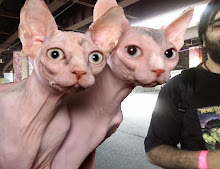 I have another memory from childhood, maybe 1983 or ‘84. My family was still living in South Texas at the time. My dad had taken me to some kind of tech show where an early computer was on display. I played some archaic computer game that had totally engrossed me. This was before Nintendo, and I think it’s what spurred my parents into getting us an Atari 2600. Anyway, later that evening, my dad called me into the living room where he was watching the news. Wouldn’t you know it? There I was on the TV, my back to the camera, playing on the computer. Yeah it was a memory that made an impression on me.
I have another memory from childhood, maybe 1983 or ‘84. My family was still living in South Texas at the time. My dad had taken me to some kind of tech show where an early computer was on display. I played some archaic computer game that had totally engrossed me. This was before Nintendo, and I think it’s what spurred my parents into getting us an Atari 2600. Anyway, later that evening, my dad called me into the living room where he was watching the news. Wouldn’t you know it? There I was on the TV, my back to the camera, playing on the computer. Yeah it was a memory that made an impression on me. Even still, the computer I played on at that convention seemed like an unattainable dream to me. I don’t think, even as young as I was, that I asked my parents if we could have one. I just intuitively knew that it would never happen. We never had lots of money. Indeed, although we had traded the Atari in for a Nintendo and later a Super Nintendo, our family didn’t get our first personal computer until over a decade later, in 1995, when my mom came home with a Pentium. I was already on my way out of high school by then. It was the days of AOL, and pay-by-the-minute connectivity, and chat rooms, keywords, screechy dialup noises. And it was thrilling.
Now the four-inch phone that I drop on a daily basis has 500 times the processing power of that Pentium. Everything is different. Remarkably so. Why do I go on about this? Well, I called this blog Something Incredible, and I find the rapid infiltration of computer technology into our lives absolutely incredible. It’s not only revolutionized daily communication and function, but it’s also revolutionized our expectations for revolutions!
“What’s next,” used to be a rhetorical response to some forward thrust in technical progress. Now it’s a real question that people ask while impatiently tapping their feet. Amazing inventions seem to become passé before a year is out. The physical manifestation of “What’s next” is the TED Conferences, where some of the most innovative minds present ideas, inventions, and projects-in-the-works to a host of gawkers, both at the conference and on the internet. These aren’t only technology-centered ideas, but it tends to lend itself toward technological innovation.
.png) The Huffington Post posted blog entry about John Underkoffler’s TED Conference presentation of a new user interface (UI) system, or the system in which a person interacts with a machine (like a computer). I didn’t know who John Underkoffler was before reading that blog, but I was familiar with his work: he was one of the science advisors for the movie Minority Report. Remember that one? Where Tom Cruise would interact with digital images that popped up in real space, rather than with a computer screen? Well, it seems Mr. Underkoffler wants to make that a little closer to reality.
The Huffington Post posted blog entry about John Underkoffler’s TED Conference presentation of a new user interface (UI) system, or the system in which a person interacts with a machine (like a computer). I didn’t know who John Underkoffler was before reading that blog, but I was familiar with his work: he was one of the science advisors for the movie Minority Report. Remember that one? Where Tom Cruise would interact with digital images that popped up in real space, rather than with a computer screen? Well, it seems Mr. Underkoffler wants to make that a little closer to reality.
I’m pretty geeky, so I think this whole thing is pretty cool. I mean, that UI was one of the most memorable things about Minority Report to me, even more so than the robot spider things. I remember sitting in the theater thinking, “damn, I want that!” Of course, the TED demonstration wasn’t exactly that, but it’s in baby stages—and we all know how fast these things can grow up.
One part of the demonstration that particularly interested me was an architecture example where he used an actual building model in tandem with a digital image. In this case the digital image was the model’s shadow, which he could alter by changing the digital position of the sun using a model clock. No computer screen—just a perfect melding of real geometric space and digital enhancement. This really stimulated my imagination as a teacher. Imagine similar techniques while teaching math or science?
Of course, I mostly just want to stand in a room and move images around in space with my hands like some kind of wacko dance. How fun would that be?



No comments:
Post a Comment